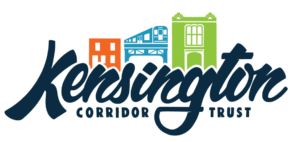
by Sarah F. Wimberley

“Property by property, we are leading a movement towards a future where neighborhoods have control.”
As a $15,000 Community Grant Awardee, Adriana Abizadeh, Executive Director, and Kensington Corridor Trust (KCT) utilize collective ownership to direct investments in the corridor that preserve culture and affordability while building neighborhood power and wealth in Kensington.
“The single most important thing that a neighborhood has in combating extractive capital practices is their collective power. Community authorship and decision-making power give a neighborhood the opportunity to not only create a vision but implement it. Through the direct use of their power to govern and control the activity, the indicators of success, and ultimately the outcomes.”
Founded in 2019, as the only Neighborhood Trust focused on a commercial corridor in the nation, the KCT educates and fosters the equitable economic revitalization of Kensington Avenue and its surrounding neighborhood through local partnerships, strategic programming, and an innovative approach to moving real estate assets out of the speculative private market. Leveraging patient, flexible capital and a long-term trust vehicle, the KCT de-commodifies real estate assets and transitions them to neighborhood control. This pioneering model of neighborhood ownership, governance and local economic development has the potential to keep control within the neighborhood and ensure long-term affordability. The KCT introduces neighborhood-based property control for long-term, equitable revitalization of a key commercial corridor.
By focusing on the community first, the KCT’s programming activities focus on restoring cleanliness and safety, attracting and accelerating businesses to provide goods and services that meet local needs, and increasing job opportunities. The Trust’s programming is underpinned by strategic property acquisition, development, and activation. The KCT leverages a Neighborhood Trust model to maintain community control of property use and values in perpetuity while reinvesting income into community programs. This framework protects the property from significant price escalation while allowing income from the property to be reinvested into community programming and improvement initiatives.
The organization’s vision for Kensington Avenue is a safe, healthy, and socioeconomically diverse commercial corridor with accessible opportunities for the existing and future residents of Kensington. The KCT lives its mission and vision through the distinct values of equity, community, stewardship, and transparency. With the acknowledgment of the organization’s strengths, weaknesses, opportunities, and threats, the organization quickly found that increasing community engagement and education were pivotal to their success. Engaging the community, including existing business owners and the youth, was also an opportunity that needed to be leveraged to aid in a better understanding of the safety challenges and financial constraints.
Now four years later, the KCT is moving towards operational sustainability through income-producing properties and commercial activity. In addition, the group has established a process for community residents and businesses to provide direct input on what is coming to the corridor, directly influencing the local economy. By offering ongoing educational workshops, real estate knowledge continues to grow while local ownership advances. Other partnerships keep green spaces clean, to maintain the momentum established.
The KCT continues to move forward to reach its strategic goals, including raising additional capital, establishing fundraising relationships, creating and building upon partnerships, and piloting a community investment program. The KCT is developing a new model for increasing neighborhood control, focused on fueling Kensington Avenue as an economic engine that can drive success in the neighborhood. The KCT recognizes how critical the development of physical space is to overcoming poverty and will leverage the area’s physical assets (transportation infrastructure, walkability, availability of properties) and neighborhood strengths (mobilized residents, strong neighborhood-based organizations) to create lasting change.

